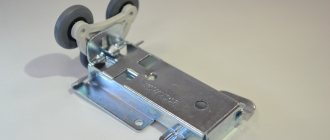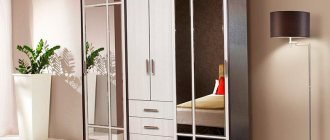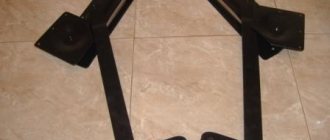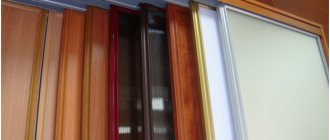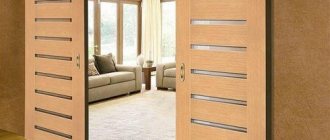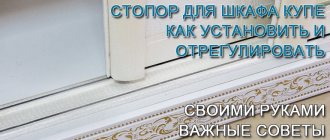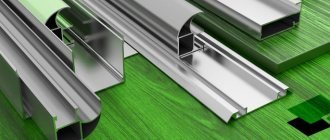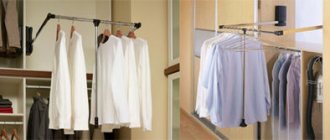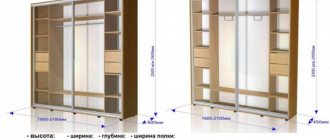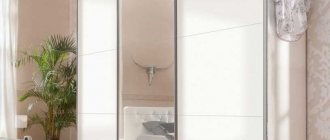Types of fittings
There are three types of furniture fittings:
- Structural . Designed for assembly of housing and facades. This includes all connecting fasteners and hinges connecting the cabinet doors to the cabinet.
- Functional . Used for internal filling of cabinets. It all depends on the destination. For kitchen furniture, for example, these are drying racks, bottle holders, and various baskets. For the dressing room - clothes rails, pantographs, trouser racks, etc.
- Facial. These are handles, various decorative corners, linings and accessories for decorating the front part of the furniture in accordance with the chosen design.
A more extensive list of fittings will be available for assembling sliding wardrobes, because it will also include sets of sliding systems. The cheapest option is a simple cabinet with shelves.
Structural fittings: fasteners for cabinet frames
Almost all cabinet furniture made of laminated chipboard is assembled using confirmata (euro screws). With rare exceptions, when hidden fasteners are required, then various types of eccentrics or, “the old fashioned way,” dowels are used. Indispensable for fastening shelves in cabinets if you want to bypass the need for through fastening and leave the sides without holes. An eccentric tie can most often be found in fastening tabletops of office furniture.
With cabinet furniture made of plywood and solid wood, there is an option for assembly with self-tapping screws. The fibrous structure of these materials even allows disassembly and subsequent assembly on this type of fastener. But the laminated chipboard will crumble - so it is better to assemble the cabinet with Euroscrews.
The back walls made of fiberboard are also fastened with self-tapping screws. Sometimes small nails are used. It is better to supplement them with small washers to increase the area of the “cap” for greater pressure of the back to the ends of the body. Washers are also used when attaching handles: if the handle screw is long, the washer acts as a “spacer”.
| Euroscrews (confirmed screws) are distinguished by head and length. The head can be designed for a hex or Phillips screwdriver. The most popular confirm length is 7x50. Less commonly used is 5x50. The length 7x70 is suitable for assembling a thickened body, for example, from 22 mm chipboard. |
| Eccentrics (minifixes) consist of three parts - the eccentric itself, the stand and the foot. They are distinguished by diameter, length, type of fastening and purpose. There are eccentrics with a convenient latch. As a fastener, an eccentric coupler is very labor-intensive and requires certain installation skills. |
| Dowels are also classified as hidden fasteners, but easier to install. Modern furniture dowels are made of plastic and metal. But wooden dowels with a corrugated surface for better grip are still popular. |
| Self-tapping screws (screws) 3-4×16 are the main type of furniture fasteners after confirmations. Using 4x16 and 3x16 self-tapping screws, screw on hinges and guides, legs and thrust bearings, corners and retractable mechanisms. |
| Self-tapping screws (screws) 4x30 are needed for attaching postforming to planks in the kitchen, as well as for assembling plywood cabinets. |
Auxiliary fasteners and fittings for cabinets
- Small nails are usually replaced with screws. But in budget furniture, where the goal is to minimize costs, nails are very often used to attach fiberboard to chipboard (bottoms of drawers, back walls).
- Furniture corners , plastic or metal. Or metal ones with a plastic cover. They are used for fastening shelves, especially often in built-in and partially built-in wardrobes and dressing rooms. Corners include console-type shelf holders, since they have a similar shape.
- Shelf holders are used to install removable shelves in cabinets. The simplest and most common ones look like a metal “barrel” with a diameter of 5 mm. For glass shelves, the range of shelf holders is much larger. There are options with fixation, with various silicone substrates and suction cups.
- Thrust bearings , simple and adjustable. They serve as a kind of gasket between the floor and the sides of the cabinet. With the help of adjustable thrust bearings, you can level the curvature of the floor and align the cabinet at a horizontal level.
- Legs and wheel supports . For kitchen cabinets, standard adjustable plastic legs with a height of 100-130 mm are used. They can be covered with a removable base. Or combined with decorative metal legs of various shapes if you do not plan to install a plinth. For office cabinets, “glass” legs with a height of 30-50 mm are often used. Wheel supports give mobility to the furniture.
Roller shutters and blinds for cabinet doors
The sectional “broken” type of sashes, by analogy with “accordions,” can be so frequent that it allows you to “wind” the facade onto a shaft. Such roller shutters and blinds can be found in the design of interior partitions. But they are also used to equip large walk-in closets and built-in wardrobes.
Electric blinds look interesting and impressive when used in cabinets.
Structural fittings: components for cabinet doors
Depending on the method of opening the cabinet doors, the appropriate fittings are selected.
Hinged doors
Manufacturers of furniture fittings offer the widest selection of hinges, allowing you to solve almost any task for swing doors.
| Standard solutions. For overhead, inset, corner facades and accordion doors made of chipboard, MDF, solid wood and plywood with a thickness of 16 mm or more, four-hinge hinges of various types are used. You can read more about the types of furniture hinges here. |
| Non-standard solutions . For doors made of glass and aluminum frames of various widths, special hinges are used. There are also options for hinges with installation at the end (for folding doors that serve as a table), with a built-in spring mechanism (if a gas lift cannot be installed), without drilling the bowl (bowlless hinges are indispensable for small façade thicknesses). |
| With additional options . Swing doors can be equipped with closers, dampers or hinges, already with a built-in soft closing mechanism. And also supplement with lifting mechanisms and electric drives of various types. This group also includes hinges for doors without handles that open when pressed. |
| A certain style. A specific type of loop - piano, ombre, heel, pin, etc. Their design itself does not imply the possibility of adjusting the facade. They will only help emphasize the special design of the furniture. |
Sliding compartment doors
Any sliding compartment system consists of three parts:
- Track (top and bottom guides).
- Set of rollers.
- Door leaves.
The leaf itself (door leaf) can be framed with profiles in the form of a frame. Or be equipped with side handles and profiles if desired.
The compartment door can be folded like an accordion. In this case, it consists of several canvases connected to each other by special loops.
In frame sliding systems, the sliding door leaf can be stacked, in combination with glass, mirrors and other materials. In this case, special dividers and a seal are used.
Varieties
Furniture fittings for cabinets include various devices to expand the functionality of products and play an important role in ensuring the comfort and durability of interior items. The components differ not only in cost and quality characteristics. Lifting and sliding mechanisms have their own design features.
Rollers
The standard kit for a wardrobe with sliding doors includes casters. They ensure the movement of the sashes along the housing strip. Some models have special bearings that prevent noise. There are two options for rollers:
- Asymmetrical. Mounted on open profiles, the sash support when moving is concentrated on the lower wheel. The upper part is supportive.
- Symmetrical. Used in designs for glass doors, plastic and mirror facades with closed handles. The lower and upper movement mechanisms are equally involved.
According to the type of design, rollers are divided into rotary and non-rotary. The first allow you to comfortably use interior items and move them around the room without effort. The latter can withstand significant loads, but are not suitable for frequent movements.
Asymmetrical
Symmetrical
Rotary
Fixed
Guides
The parts consist of two parts: one is installed on the top panel, the other at the bottom. The door leaf moves between them. There are three types of guides:
- single-lane;
- two-way;
- three-way.
Folding door tracks are available in plastic, aluminum or steel. When choosing, take into account the maximum permissible load on the fittings. Fragile products cannot be used for massive doors.
Single-lane
Two-way
Three-way
Plastic
Aluminum
Steel
Profiles
These elements form the frame of the door leaf. Vertical profiles additionally serve as handles. They produce two types of products:
- Steel, from sheets 0.3-0.8 mm thick. They are classified as an economy option, they are not rigid enough, and the color choice is limited.
- Aluminum, belonging to the expensive segment. They are durable, tough, and come in any color.
To ensure silent operation of cabinet doors, you should choose aluminum profiles coated with PVC. Used to make doors up to 320 cm high.
Characteristics of beech furniture panels, main advantages
Steel
Aluminum
Stopper
The stopper is attached to the lower guide. When the sash opens, the roller gets between the plates and blocks the door. When choosing a stopper, preference is given to a durable steel product. You can ignore it when there are no more than two doors. Otherwise, operating the cabinet without this type of fittings will become unsafe.
Sliding system
Sliding type systems are basic. Thanks to these mechanisms, the doors move. They produce two types of fittings:
- support ones, consisting of a pair of guides, rollers and a profile;
- suspension systems that include a top guide, a roller carriage and a stopper.
The sliding mechanism is selected depending on the dimensions of the door leaves, the material of manufacture, and the opening option. Support systems fit large doors. It is not necessary to frame the canvas with a profile on hanging fittings.
Support
Hanging
Sealant
The exact fit of the door to the body depends on correctly selected seals. They can be silicone or polyurethane. It is important to choose a reliable, easy-to-use option. Types of seals:
- U-shaped - for facades made of plastic, glass, mirror, less often aluminum profiles with a thickness of 4 mm, 8 mm;
- herringbone type - a special type of design, installed for glass doors.
Schlegel is glued to the grooves of the vertical guides. A soft brush softens the impact of the door leaf on the body. The service life of furniture is extended thanks to seals.
Silicone
Polyurethane
U-shaped
By type of Christmas tree
Schlegel
Functional fittings for the interior filling of cabinets
The main content of the cabinets are shelves. Most often they are made of the same material as the body. They can be rigidly attached, removable or retractable.
Glass shelves are installed in sideboards, kitchen cabinets and display cases. And in wardrobes and dressing rooms you can often see mesh shelves.
Drawers
The second significant element of the cabinet after the shelves can be called a drawer. It can be installed using various guides.
| Roller guides . The cheapest type of all on the market. |
| Ball (telescopic). They can be full or partial extension, with a built-in closer, depending on the design. |
| Metalboxes (metaboxes). They have better load-bearing capacity, since they require the installation of a bottom made of chipboard. |
| Extension systems with closers and pushers . The most expensive type of guides of complex design. |
Manufacturing materials
The durability and comfort in use of furniture depend not only on the design features of the fittings. It is important what material the product is made of. It can be:
- cast brass;
- cast zinc;
- aluminum alloys;
- stainless steel;
- plastic.
Types of furniture guides, their installation and selection criteria
Cast brass
Cast zinc
Aluminum alloys
Stainless steel
Plastic
Treatment of materials from exposure to chemicals, moisture, to increase mechanical wear resistance is carried out in the following ways:
- Chrome plating. A semi-gloss nickel layer is electrolytically applied to the base material, then chrome-plated. For a matte effect, a special alloy is used before processing.
- Grinding. The mechanically processed material is varnished. This prevents the oxidation of the metal. With intensive use, the varnish wears out.
- Polishing. The material is polished manually or using machines. Brass is covered with patina.
- Anodizing. This is a high-quality anti-corrosion oxide coating. Created as a result of an electrochemical reaction.
- Oxidation. A layer of copper is electrolytically applied to the metal and covered with a film. Protect the top with varnish.
- Galvanizing. This coating involves chrome plating. This improves corrosion resistance.
- Powder coated polyester. Forms a hard film at an elevated temperature of 200 degrees. Such fittings cannot withstand intensive use.
Purpose and types of furniture hinges, installation nuances
Plastic fittings have become popular lately. High strength characteristics are combined with wear resistance. Plastic has antistatic properties and is ideal as a construction material for fittings.
Chrome plating
Grinding
Polishing
Anodizing
Oxidation
Galvanizing
Powder coating
Filling wardrobes
What will allow you to store things more neatly and systematically? Various additional devices in the form of hooks, pockets, hangings, drawers with special divisions for placing ties, belts, jewelry, etc. You can also classify into a separate group retractable trousers, shelves and baskets for shoes, bags of specific shapes, ironing boards folded out of niches, rotating mirrors and other mechanisms.
A separate group includes devices for placing clothes on hangers. First of all, this is the Joker system: a round metal pipe with a diameter of 25 mm, which can be equipped with flanges, various holders and adapters. For shallow cabinets, pull-out cross bars are used. The premium segment includes pantographs.
For large wardrobes and dressing rooms, entire storage systems are offered - Elfa, Aristo, Algot, Stolman and others. The main thing is to arrange them according to the correct calculation of the width of the sliding compartments, so that the internal filling is functional and comfortable.
